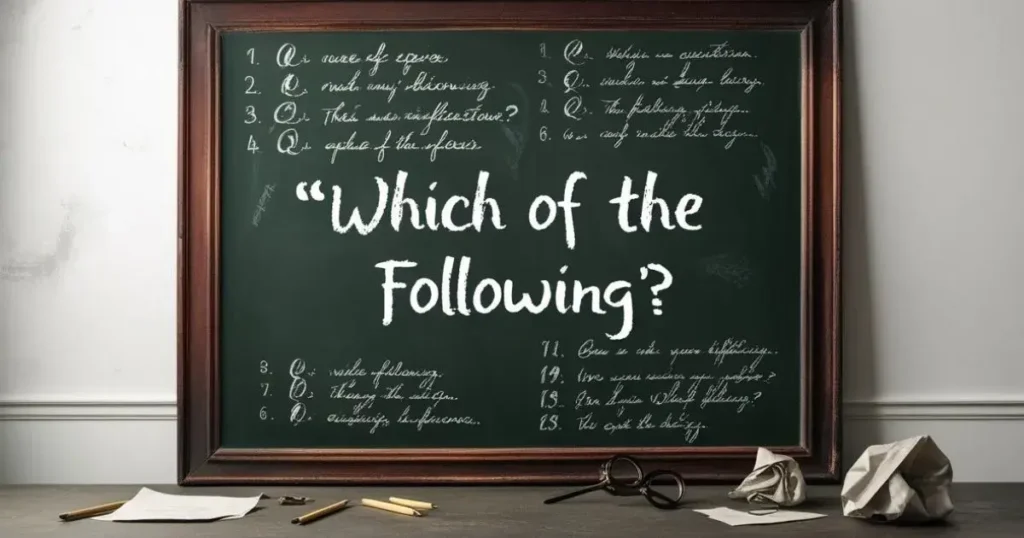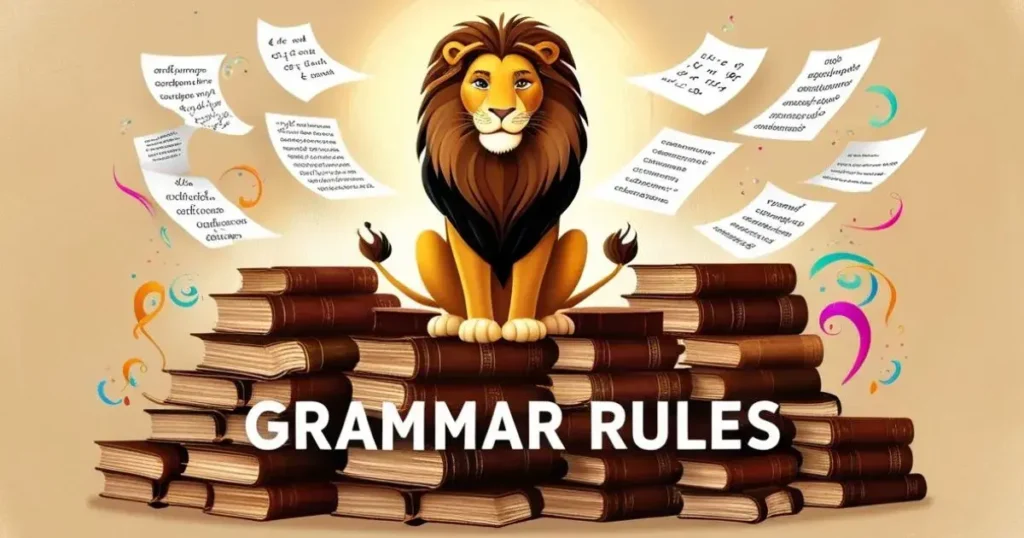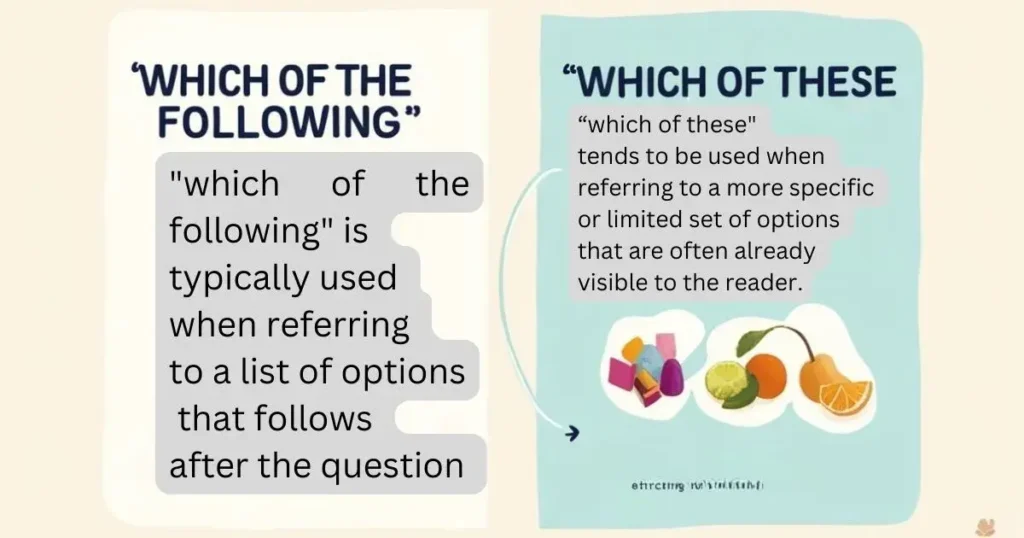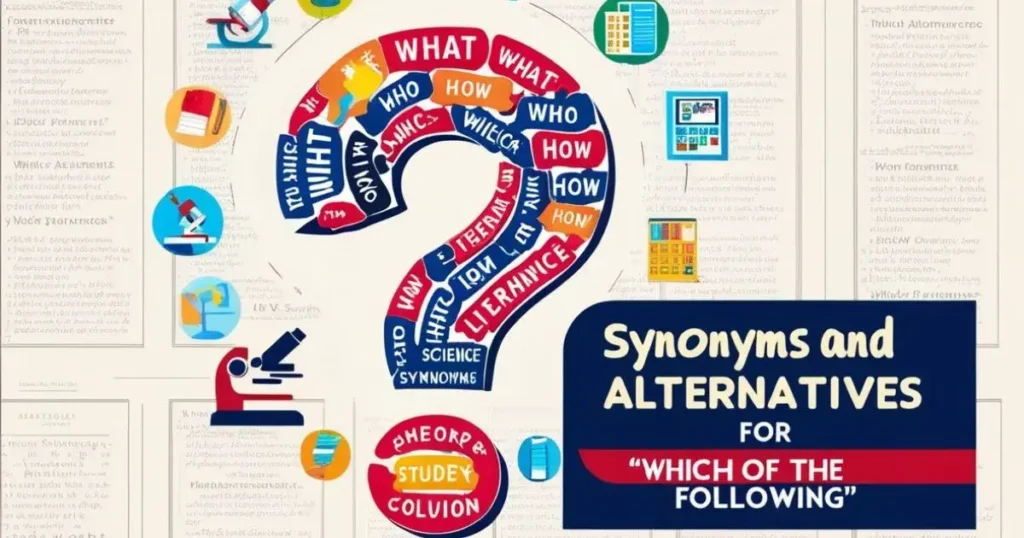The phrase “which of the following” is a staple in a variety of contexts, from multiple-choice questions (MCQs) to surveys, exams, and educational materials. Whether you’ve encountered it in a quiz, a research survey, or as part of an instructional guide, understanding how to use this phrase correctly is essential for clear communication and proper grammar.
In this article, we’ll explore the meaning, usage, and grammar rules behind “which of the following”. We’ll break down its different applications, review essential grammar rules like subject-verb agreement, and provide practical examples across a variety of contexts, from quizzes to instructional materials.
By the end of this post, you’ll feel confident in your ability to use “which of the following” correctly in any setting, ensuring clarity and accuracy in your writing and communication.
What Does “Which of the Following” Mean?

Definition
The phrase “which of the following” is commonly used to introduce a list of options or choices, where the reader or listener is expected to select the correct or most appropriate option.
It is most often found in multiple-choice questions (MCQs), surveys, exams, and assessments. It helps narrow down the focus of a question and directs the responder to a specific set of alternatives from which they need to make a selection.
Examples:
- Which of the following is the capital of France?
a) Berlin
b) Madrid
c) Paris
d) Rome - Which of the following is NOT a winter sport?
a) Skiing
b) Swimming
c) Ice hockey
d) Snowboarding
This construction helps to create contextual clarity, ensuring that the reader understands exactly what they are supposed to evaluate.
How to Use “Which of the Following”
The structure of “which of the following” is relatively simple, but it is important to adhere to certain grammatical rules to ensure clarity and correctness.
In most cases, the phrase is followed by a set of options, typically presented in a list format. The most common scenarios where you’ll encounter this phrase are in quizzes, surveys, tests, and educational contexts.
Sentence Construction
When using “which of the following”, the phrase is typically used at the beginning of a question or sentence, followed by the options, and then the verb that agrees with the subject.
For example:
- Which of the following options is the correct answer?
- Which of the following animals is a reptile?
- Which of the following is a prime number?
Subject-Verb Agreement
Subject-verb agreement plays a crucial role in the proper use of “which of the following”. The verb you choose should align with the subject it’s referring to. If you’re listing singular items or concepts, use a singular verb, such as “is”. If the subject is plural, use the plural form, “are”.
Singular Verb Example:
- Which of the following is a mammal?
a) Bear
b) Lizard
c) Bat
d) Whale - Correct Answer: Bear (singular)
Plural Verb Example:
- Which of the following are mammals?
a) Bear
b) Lizard
c) Bat
d) Whale - Correct Answer: Bear, Lizard, Bat, Whale (plural)
Remember, it’s crucial to ensure contextual clarity when structuring your sentences. The options should be clearly delineated, and the grammar rules must be followed to prevent any confusion.
Complete Usage

The phrase “which of the following” is a versatile tool in both written and spoken language, commonly used in quizzes, exams, surveys, and even instructional materials.
It serves as a way to introduce a list of options or choices, prompting the reader or listener to select the correct or most appropriate answer from the set of alternatives.
In a Science Test
In science tests, “which of the following” is frequently used to test knowledge on scientific facts, processes, and classifications. It’s especially helpful when there are multiple choices related to concepts such as biology, chemistry, physics, or earth science.
The phrase allows the question to present specific options for the test-taker to identify the correct one.
Example:
“Which of the following elements is a noble gas?”
- a) Oxygen
- b) Nitrogen
- c) Argon
- d) Hydrogen
In this case, Argon is the correct answer, but the other options serve as distractors. Noble gases are a category of elements in the periodic table that are characterized by their lack of reactivity under most conditions, and they are often the subject of such questions.
In a History Quiz
The phrase “which of the following” is also commonly used in history quizzes or questions about historical events, periods, and figures. In these settings, “which of the following” helps present various historical facts, requiring the participant to select the one that aligns with a particular statement or query.
Example:
“Which of the following events occurred first?”
- a) Magna Carta
- b) American Revolution
- c) French Revolution
- d) Industrial Revolution
This question uses “which of the following” to test the participant’s knowledge of historical chronology. The correct answer here would be Magna Carta, which was signed in 1215, earlier than the other events listed.
In a Survey or Poll
In surveys or polls, “which of the following” serves to present a list of options from which respondents can select their preferences, opinions, or feelings. This phrase is particularly useful in gathering data, as it allows clear and concise choices for the participant.
Example:
“Which of the following features do you find most useful in our product?”
- a) Ease of use
- b) Customer support
- c) Price
- d) Functionality
This question aims to gather valuable feedback from users, helping a business understand which feature is most important to their customer base.
In Multiple Choice Questions (MCQs)
The phrase “which of the following” is commonly found in multiple-choice questions (MCQs), a popular assessment format in education and testing environments. These types of questions require the participant to choose the most appropriate or correct option from a set of answers.
Example:
“Which of the following is a correct answer?”
- a) The Earth is flat.
- b) The Earth is a sphere.
- c) The Earth is a cube.
- d) The Earth is hollow.
This is an example of a factual question, where the participant must identify the correct statement. However, In this case, the correct answer would be The Earth is a sphere, which is a scientifically accepted fact.
In Instructions or Guides
In instructional materials such as guides, handbooks, or how-to documents, “which of the following” is used to present steps or procedures in a list, directing the reader through a process.
Example:
“Which of the following steps should you take next?”
- a) Close all open programs.
- b) Turn off the computer.
- c) Back up your files.
- d) Restart your system.
The reader can choose the most appropriate next step based on their needs. It’s clear, concise, and helps ensure that users can follow complex tasks with ease.
Grammar Rules

Correct grammar usage is essential when employing the phrase “which of the following”. There are several grammatical considerations to keep in mind, including subject-verb agreement, punctuation, and sentence structure. Let’s take a closer look at these grammar rules.
Subject-Verb Agreement
One of the most important grammatical aspects to consider when using “which of the following” is subject-verb agreement. The verb used in the sentence must agree with the subject that is being referred to.
When the subject is singular, you should use a singular verb like “is”; when the subject is plural, you should use the plural form, “are”.
| Subject | Verb Agreement | Example |
|---|---|---|
| Singular subject | Is | Which of the following is a reptile? |
| Plural subject | Are | Which of the following are mammals? |
Choosing Between “Is” and “Are”
In most cases, “which of the following” introduces a list of options, and the verb that follows depends on whether the options are singular or plural. Understanding the subject-verb agreement is key to proper grammar in these situations.
Using “Is” with Singular Subjects
When the subject is singular (meaning only one option is correct or the focus is on a singular noun), use “is”.
Example:
“Which of the following is a reptile?”
- a) Lizard
- b) Seal
- c) Bear
- d) Dog
The correct answer here is Lizard, and because only one subject (the reptile) is being referred to, the verb is “is”.
Using “Are” with Plural Subjects
When the subject is plural (when there is more than one correct answer or the options refer to multiple items), use “are”.
Example:
“Which of the following are mammals?”
- a) Bear
- b) Lizard
- c) Bat
- d) Whale
In this case, the correct answers are Bear, Bat, and Whale because they are all mammals, and because multiple answers are correct, the plural form “are” is used.
Punctuation
When writing questions with “which of the following”, the sentence should typically be followed by a colon or question mark. Use a colon to separate the question from the options in formal writing, and a question mark at the end of the question to indicate it’s an inquiry.
Example:
“Which of the following:
a) Mammals
b) Birds
c) Fish”
Or:
“Which of the following is the correct answer?”
Capitalization
Capitalize the first word of each option listed after “which of the following”. This ensures clarity and readability. All options should begin with a capital letter to maintain consistency.
Example:
Which of the following cities is the capital of Germany?
a) Berlin
b) Madrid
c) Paris
d) Rome
Question Mark
When using “which of the following” as part of a question, always use a question mark at the end of the sentence to indicate that you are asking a query.
Example:
“Which of the following animals is a mammal?”
- a) Dog
- b) Shark
- c) Elephant
- d) Snake
Colon Usage
In some cases, especially in formal settings, it is appropriate to use a colon after “which of the following” to introduce a list of options.
Example:
“Which of the following are countries in Europe:
a) France
b) Italy
c) Canada
d) Japan”
Using “Which of the Following” in Different Contexts

Multiple-Choice Questions (MCQs)
In multiple-choice questions (MCQs), “which of the following” is used to present a set of choices, usually in a quizzes or exams. The options are distractors, meaning some are incorrect answers designed to challenge the respondent.
Example:
Which of the following are adverbs of time?
a) Never
b) Always
c) Now
d) Here
- Correct Answer: Never, Always, Now, Here
This format is common in assessments and helps gauge understanding of specific concepts, such as parts of speech (e.g., adverbs of time).
In Surveys and Polls
“Which of the following” is an ideal phrase in survey settings, as it simplifies the collection of feedback from respondents.
Example:
Which of the following would you prefer in your ideal vacation?
a) Swimming
b) Hiking
c) Skiing
d) Relaxing on a beach
- Correct Answer: This would depend on individual responses.
Surveys often use multiple-choice format questions to simplify the process of data collection. Using “which of the following” allows for clarity and makes the response format predictable.
In Formal vs Informal Contexts

“Which of the following” is a versatile phrase used across both formal and informal writing, but its tone, purpose, and usage can vary depending on the context.
Understanding when and how to use this phrase appropriately in both types of writing will help ensure your communication is clear and effective.
Can “Which of the Following” Be Used in Casual Writing?
Yes, “which of the following” can certainly be used in casual writing, although it may be seen more frequently in formal contexts. In informal writing, such as personal emails, social media posts, or blogs, the phrase can be used to pose questions or present choices when the tone is conversational and the audience is more relaxed.
Example of Casual Usage:
“Which of the following movies should we watch tonight?”
- a) Action
- b) Comedy
- c) Drama
- d) Documentary
In Formal Contexts
In formal writing, “which of the following” is much more prevalent, particularly in educational settings, surveys, questionnaires, exams, and other types of professional or academic materials.
This phrase helps maintain clarity, organization, and precision in conveying questions where the reader needs to select the best possible answer from a given list of options.
Example of Formal Usage:
“Which of the following statements is true about the Industrial Revolution?”
- a) It began in the early 19th century.
- b) It had no significant impact on urbanization.
- c) It was characterized by a decline in factory jobs.
- d) It had little influence on technological progress.
In Instructional Texts
Instructional materials such as guides, manuals, and how-to articles rely on clarity and precision to help readers follow processes or steps effectively. “Which of the following” is particularly useful in such settings because it enables writers to present clear, step-by-step options or instructions, ensuring the user understands the choices and actions to take next.
In instructional texts, this phrase can be used to introduce a list of options, helping the reader navigate through a process or decide on the next course of action. It’s especially helpful when complex tasks or decisions are involved, and there’s a need to present multiple choices with clearly defined answers.
Using it for Clarity and Precision in Directions
When providing directions or guidelines, “which of the following” serves to organize the available steps or choices in a logical and accessible way. It also aids in minimizing ambiguity, as it forces the reader to focus on the specific instructions or options provided.
Whether for technical writing, product setup, or workflow instructions, the phrase helps break down complex tasks into more digestible parts.
Example in Instructional Texts:
“Which of the following steps should you take to properly assemble the bookshelf?”
- a) Attach the side panels to the base.
- b) Secure the back panel to the side panels.
- c) Place the shelf supports into the side panels.
- d) All of the above.
This question allows the reader to identify the correct order of actions or decide which step is most appropriate at a given moment. It enhances comprehension by narrowing the focus to specific choices, helping the user understand and follow instructions with greater confidence.
Why It Works Well in Instructional Texts
Using “which of the following” in instructional texts provides several benefits:
- Clarity: It ensures that the choices are presented clearly, which is vital in instructions where the reader may be unfamiliar with the subject matter.
- Conciseness: It allows the writer to efficiently list options, avoiding lengthy explanations or overcomplicated wording.
- Precision: This phrase guides the reader in making a specific choice, which is key in tasks that involve following sequential steps or making a correct decision.
Example of Instructional Usage:
“Which of the following ingredients do you need to make a traditional Caesar salad?”
- a) Romaine lettuce
- b) Croutons
- c) Anchovies
- d) All of the above
This example is useful in a cooking guide, where the reader can select the necessary ingredients from the list to prepare the dish.
“Which of the Following”: Understanding Its Complete Usage and Grammar
The phrase “which of the following” is commonly used in various writing contexts to present options or choices. It’s a useful tool for organizing multiple-choice questions, surveys, quizzes, or any scenario that involves providing a list of choices for the reader or audience.
“Which of These” vs. “Which of the Following”

Both “which of the following” and “which of these” serve similar purposes, but there are key differences that influence how and when you should use them.
Difference Between “Which of the Following” and “Which of These”
While “which of the following” is typically used when referring to a list of options that follows after the question, “which of these” tends to be used when referring to a more specific or limited set of options that are often already visible to the reader.
- “Which of the following” is used when the options are about to be introduced in the text, as in a multiple-choice quiz or survey question.
Example:
“Which of the following is a mammal?”
a) Bear
b) Lizard
c) Seal
d) Snake - “Which of these” can be used when the options are already visible, typically pointing to a set of objects or items the reader can already see or is familiar with.
Example:
“Which of these items would you like to buy?”
In short, “which of the following” introduces a list, while “which of these” refers to an already known or presented set of items.
“Which of Whom”
Though “which of whom” might sound odd, it has its place in certain contexts. This phrase is more commonly used in formal, academic, or legal writing when referring to a group of people.
It is grammatically correct when you need to specify a subset of individuals, especially when the subject in question is human.
When is “Which of Whom” Correct or Useful in Writing?
“Which of whom” is typically used when referring to a selection of people, as in a question about individuals within a group. The key here is that the word whom refers to the object of the preposition (e.g., in a group of people).
Example:
“Which of whom should we invite to the party?”
In this case, “whom” refers to people, and you’re asking which of those people is the correct choice. It’s more formal and specific compared to just saying “who”.
In everyday conversational English, you might avoid this phrasing due to its formality, but it’s still grammatically accurate in contexts that require precision, especially in academic writing.
“Which of the Following Is Not”
In many scenarios, you may want to pose a question that asks for the exception from a list of items or choices. The phrase “which of the following is not” helps you structure these questions efficiently.
Example: “Which of the following is not a fruit?”
- a) Apple
- b) Carrot
- c) Banana
- d) Pear
Here, the question is set up to test knowledge by identifying the incorrect item among a list. This format is widely used in both quizzes and educational assessments.
In multiple-choice questions (MCQs), asking questions like “Which of the following is not…” can help assess critical thinking skills by requiring the participant to understand exceptions or identify items that do not belong in a category.
“Which of the Following + Plural Noun”
One of the most important things to keep in mind when using “which of the following” is ensuring that the noun used after it agrees in number with the subject of the sentence.
Clarification of Plural Noun Use
When using “which of the following”, you need to ensure that the noun following it matches the subject in number, whether singular or plural. If you’re listing multiple items (a plural noun), you will need to ensure the verb is also plural.
For example:
- Singular noun usage:
“Which of the following is a reptile?”
The subject (reptile) is singular, so the verb “is” is used. - Plural noun usage:
“Which of the following are reptiles?”
The subject (reptiles) is plural, so the verb “are” is used.
Is It Correct to Use “Which of the Followings”?
The phrase “which of the followings” is grammatically incorrect and awkward. While the phrase “which of the following” is perfectly acceptable, adding an “s” at the end of “following” makes it incorrect.
Why “Which of the Followings” is Incorrect or Awkward
The term “following” is already a plural word when used in this context. Adding an “s” creates redundancy and disrupts the natural flow of the sentence.
Correct example:
“Which of the following is the best option?”
Incorrect example:
“Which of the followings is the best option?”
Synonyms and Alternatives for “Which of the Following”

While “which of the following” is the most widely used phrase in many contexts, there are several alternatives or synonyms that can convey a similar meaning in different situations. These alternatives can help avoid repetition or adjust the tone of the writing.
Synonyms
- “Which among the following”
- “Which of these options”
- “Which of these choices”
- “Which one of the following”
Can You Use “Which of the Below” Instead?
In some cases, “which of the below” might seem like an appropriate alternative, especially in informal writing. However, it’s not as formal or polished as “which of the following”, and it may not always be suitable in professional or academic writing.
“Which of the following” is preferred because it conveys clarity and precision, which is crucial in more formal or academic contexts.
Example:
Correct: “Which of the following is a mammal?”
Less formal: “Which of the below is a mammal?”
Tips for Proper Usage of “Which of the Following”
To make sure you’re using “which of the following” correctly, here are a few tips to keep in mind:
- Avoid redundancy: Make sure your phrasing is straightforward and not overly wordy. Stick to concise language.
- Double-check subject-verb agreement: As mentioned earlier, make sure your subject and verb agree in number (singular or plural).
- Ensure clarity: When listing options, make sure they are clear and easy to understand.
- Keep questions direct and concise: If you want to list options, make sure the phrasing of the question is precise. Avoid adding unnecessary words.
Common Mistakes to Avoid
Even though “which of the following” is a useful phrase, there are common mistakes that can undermine its effectiveness. Here are some mistakes to look out for:
- Overcomplicating sentence structure: Keep the structure simple and clear.
- Mixing singular and plural subjects inappropriately: Always match your verb with the subject.
- Using awkward or incorrect phrasing: For instance, “which of the followings” is incorrect.
- Misplacing punctuation marks: Ensure your question ends with the correct punctuation (e.g., a question mark) when using “which of the following”.
Conclusion
Mastering the use of “which of the following” is essential for effective communication in multiple-choice questions, surveys, and educational settings. By understanding the grammar rules behind subject-verb agreement, punctuation, and capitalization, you can ensure your writing is clear, correct, and easy to follow. Whether you are preparing tests, quizzes, or instructional materials, “which of the following” provides a straightforward way to present options to your audience.
By following the tips and guidelines in this post, you’ll be well-equipped to use “which of the following” correctly in any assessment or survey setting, whether you’re designing multiple-choice questions or analyzing responses.

This author is a passionate linguist and grammar enthusiast, dedicated to helping individuals master the art of language. With years of experience in teaching and editing, she brings clarity and precision to every sentence. Tina’s mission is to empower writers of all levels to express themselves with confidence and excellence.

